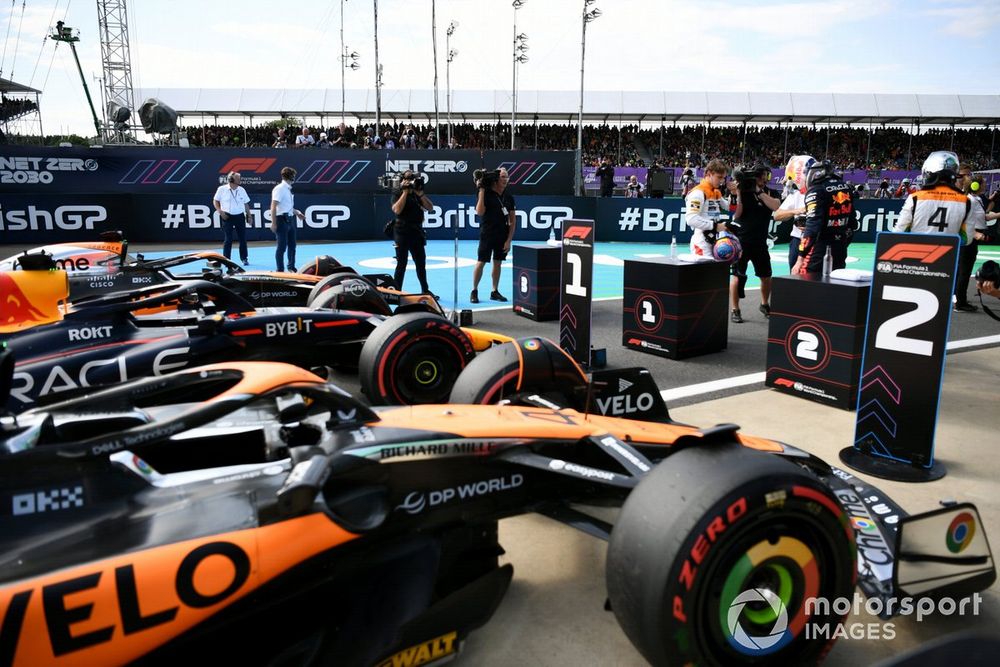
On one side of the debate is the FIA, which is pushing hard to expand the grid beyond the current 10 teams as it sees nothing but positives from the arrival of the Andretti-Cadillac operation.
Opposing that push, however, are the teams, who think that an 11th squad will bring no tangible benefit.
Furthermore, they fear that sharing the prize pool with another team risks bringing financial uncertainty for operations that just three years ago were on the brink during the COVID pandemic.
Sitting somewhere in the middle, but clearly lukewarm to the whole idea, is FOM, which is clear that it will only hand out a commercial deal to Andretti if its analysis shows it would be accretive to F1 as a whole.
While the current teams have no formal say on what FOM's final decision will be, their resistance will likely be a key factor in swaying F1 CEO Stefano Domenicali's final opinion on the matter.
And, critical to the negativity towards Andretti, is the fear from some teams that adding an 11th squad to the grid could risk their own future.
Williams team principal James Vowles made it clear at the recent Qatar Grand Prix that squads like his were still on the knife edge when it came to finances, so losing prize money and value would not be a good thing.
"My responsibility is to 900 employees within my company," he said. "If you go look at Companies House, you can go look it up for Williams, we've submitted it now, you can see that we're lossy. We're very lossy.
"In fact, compare it from '21 to '22, you'll see that losses are in the tens of millions more. Compare it to '23, which you won't see but I'll guarantee you, it's multiples above that."
But would Andretti's arrival and the subsequent reshuffling of the commercial rights income really have that much of an impact in making things worse, especially if it stumps up the $200 million dilution fund payment first?
Here we look at the figures involved to get a better picture of what is at stake.

Prize money payments
Formula 1's exact prize money split is secret, with its details enshrined in the commercial element of the two Concorde Agreements that effectively govern the series.
However, using information that is available in the public domain – including the published accounts of both teams and F1 owners Liberty Media – it is possible to ascertain a pretty good idea of how the commercial pot is split up.
The best estimation is that, according to the terms of the Concorde Agreement, the team prize pot is made up of 50% of the overall commercial rights profit that the sport generates.
However, it is understood that after a certain point of revenue, FOM's percentage share shifts up so it keeps more than half from that figure onwards. It means teams do not always get a straight 50% of the money.
In 2022, for example, with F1 generating $2.57 billion in revenue, team payments totalled $1.157 billion, which equates to roughly 45% of the total income.
These payments are not shared equally among all the teams, however.
First of all, Ferrari continues to have an extra payment for its historical significance, which is believed to be 5% of the total pot.
Teams that have achieved success in the constructors' championship in recent years also qualify for a simple bonus (from having won one title) or a bigger payment (for winning two or more).
There is also understood to be a separate pot based on extra payments for teams that have finished in the top three of the constructors' championship in the previous 10 years.
This currently includes Mercedes, Red Bull, Williams, Ferrari, and McLaren.

It is estimated that all these bonus payments account for around 25% of the total prize pot distributed to teams.
Once these payments have been made, the rest of the money is distributed among the teams on a sliding scale basis, with the top team getting 14% and the bottom squad getting 6%.
With F1's predicted earnings expected to rise by around 8% - 10% annually, it means that team payments totalling around $1.25-1.3 billion can be anticipated over the next few years.
The 11th team impact
Should Andretti arrive on the grid, then the impact will only be on the pot of money that is distributed after the bonuses for the top squads.
So, for simplicity reasons, if we judge that the final payment pot is $1 billion with the extra bonuses that have been taken out, here is how the payments would shift with an 11th team on the grid.
Based on a 10-team grid distributing $1 billion, the payout would be as follows based on constructors' championship position.
Team prize money payouts for 10 teams based on $1 billion fund
| Position | Percentage | Prize money |
| 1 | 14% | 140m |
| 2 | 13.1% | 131m |
| 3 | 12.2% | 122m |
| 4 | 11.3% | 113m |
| 5 | 10.4% | 104m |
| 6 | 9.5% | 95m |
| 7 | 8.7% | 87m |
| 8 | 7.8% | 78m |
| 9 | 6.9% | 69m |
| 10 | 6% | 60m |
| Position | Percentage | Prize money |
| 1 | 13.3% | 133m |
| 2 | 12.5% | 125m |
| 3 | 11.6% | 116m |
| 4 | 10.8% | 108m |
| 5 | 9.9% | 99m |
| 6 | 9.1% | 91m |
| 7 | 8.3% | 83m |
| 8 | 7.4% | 74m |
| 9 | 6.5% | 65m |
| 10 | 5.7% | 57m |
| 11 | 4.9% | 49m |
Comparing the two tables, it shows that the arrival of Andretti – if the prize pot did not increase – would trigger a $7m loss for constructors' champions Red Bull.
The team that finished fifth would lose $5 million, while the 10th placed squad would go from $60m to $57m, a drop of three million per year.
This loss of commercial income for everybody is why the 2021-2025 Concorde Agreement included the famous $200m dilution fee, which was intended to cover any such losses in prize income for several years.

On a basic level and distributed as a straight upfront payment of $20 million each, the dilution fund would offset TV losses across half the grid for some time.
And that is before taking into account potential increases in revenue, which could go up by 8% each year anyway based on FOM's success.
Furthermore, in financial terms, having a $20 million upfront payment is worth more than having it spread out over several years.
This is especially true when talking about what is known as the discount rate that accountants use to balance the value of income now versus it arriving later.
Still resistance
But while the year-by-year losses for teams do not look that dramatic, what they do not take into account is the biggest element of concern, which is related to the impact that Andretti's arrival would have on the value of teams.
With the current price tag of an F1 operation being around the $1 billion mark, Andretti getting into F1 for just $200 million is something that could potentially set a precedent in dropping the value of the current squads.
It is little wonder then that there is talk of the dilution fee being raised to $600m or more in 2026 when the new Concorde Agreement comes out.

That may seem excessive in terms of the prize money impact. But, for the current teams, they believe it makes more sense to stabilise the value of those involved in F1 right now.
As Red Bull team boss Christian Horner told Sky F1 recently: "I think that when you look at how Audi has come into the sport, they've acquired an existing team and an existing franchise, should it be different for the others?
"I think that's where Liberty and the FIA need to get together and come to us with a collective position. Because you can't have one rule for one, and another for others.
"Obviously, money makes the world go round. And that's what every team will be acutely sensitive of, and the franchise value being diluted. Suddenly you go from 10 to 11. So, of course, the stakeholders, the shareholders of each individual team will have a concern about that."
The key thing for Andretti is whether those concerns are enough to convince FOM to not give it the deal it wants.







